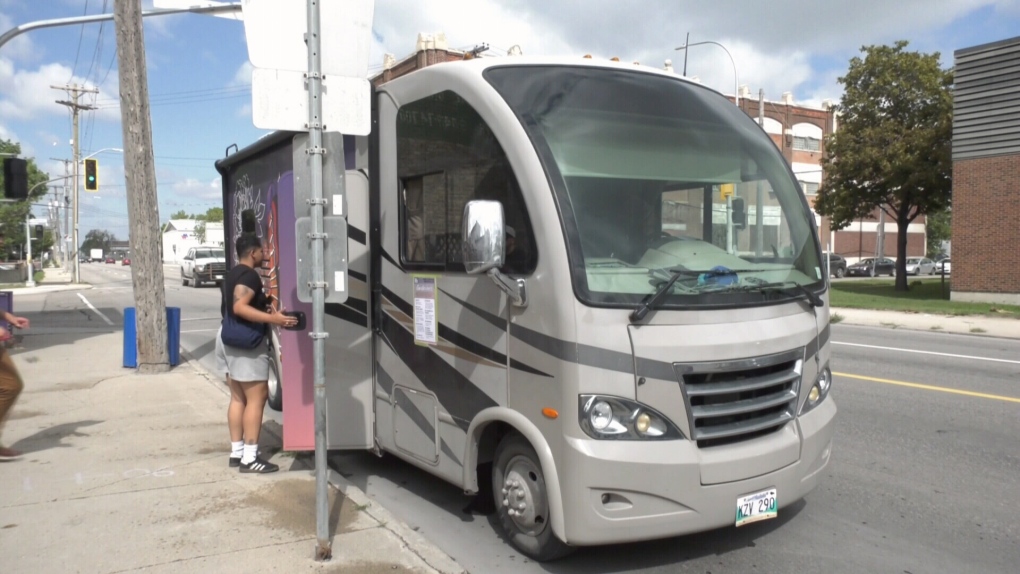‘This program has saved lives’: New report highlights success of Mobile Overdose Prevention Site during first year of operation

A new report looking at the use of the Mobile Overdose Prevention Site (MOPS) operated by Sunshine House in Winnipeg said it has “successfully exceeded its benchmarks” in its first year of operation.
The mobile site was launched late in 2022, and provides people a space where they can use drugs and be supervised by staff who have been trained to deal with overdoses.
The 91-page report found the site had more than 26,000 visits, with just over 7,000 of those to use drugs.
Of all the visits, only 20 were considered an overdose, naloxone was administered 82 times and four people requested to be taken to hospital. No deaths were reported at the site.
“This program has saved lives and changed lives, and continues to serve Winnipeg’s vulnerable populations with care and compassion,” the report said.
Levi Foy, the executive director of Sunshine House, said this site has helped reduce the strain on the health-care system as well.
“The effects of that are palpable because when people are provided with a safe space, we don’t have to call the emergency lines as much. People don’t die,” said Foy. “We’ve never had any kind of extreme events that’s happened at the overdose prevention site and we actually call paramedics for overdoses or toxic drug events, less than one time a day.”
When the site first opened up in November 2022, there were 782 visits that month. By November 2023, it had 3,601 visits.
Drug visits also went up from 101 in November 2022 to 953 in November 2023.
Foy said while this offers a safe space for people, it also gives people the chance to connect and potentially look for options to get help.
“We’re really focused at the Mobile Overdose Prevention Site (on) cultivating connection. So when folks are there, maybe they don’t need to use as much. Maybe they won’t need to use as frequently. Maybe they can have conversations about what rapid access to addiction medicine looks like.”
As part of the report LAHRK Consulting – the organization that prepared the report – spoke with over 600 people, ranging from people who have used the site to MOPS workers and workers at other community organizations.
“Whether they use drugs or not, they just found the overdose prevention site to be an incredible service and an incredible space for building community and building connections and helping people build better lives,” said Kerniel Aasland, a consultant with LAHRK.
The report also found the importance of having peers – people with a lived drug experience – involved with the site.
“The peers successfully created a warm and welcoming environment, and shaped programs and services to the specific needs of users. The peers drew from their lived experience, to meet innately-organized needs, and were able to address potential conflict in a timely manner,” the report said.
The report also found that while there was success in the first year of the mobile site, a permanent supervised consumption site is needed to reach even more people.
As part of the new provincial budget, the Manitoba government has set aside $2.5 million for a brick-and-mortar site in the North Main Street area.
“OPS (overdose prevention sites) and SCS (supervised consumption sites) are needed throughout Manitoba. Ideally, several SCS should be created with satellite services that operate as OPS or MOPS,” the report said.
Foy said Sunshine House has had “very good” conversations with the provincial government about what they do, but noted their mobile site isn’t the answer to everything.
“We want to be a part of a much broader solution that really involves a lot of other community partners, a lot of other agencies who have ideas on how to best serve their community, because we know what works for us and that’s not going to work for everyone,” said Foy.
Foy notes the mobile service is still needed and even when a supervised consumption site opens up, the mobile site will have a purpose.
“Mobility allows you a lot of opportunity that having a brick and mortar doesn’t. So we can go and soften neighbourhoods, we can work with other community organizations who might be willing to pilot this. We can be a little bit more mobile overnight or in the evenings when many health-care professionals aren’t working.”
View original article here Source




